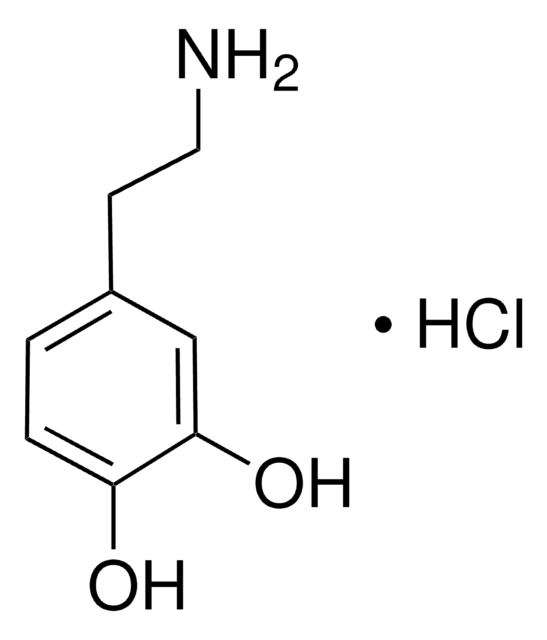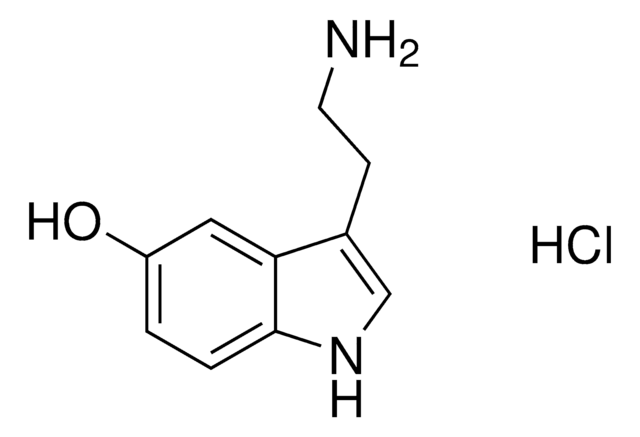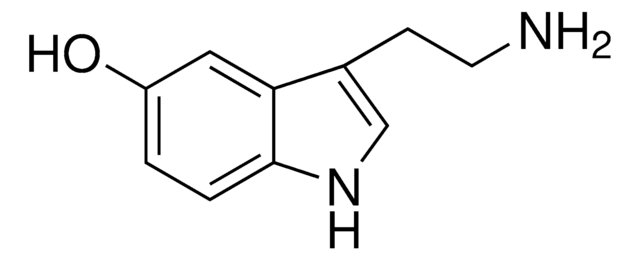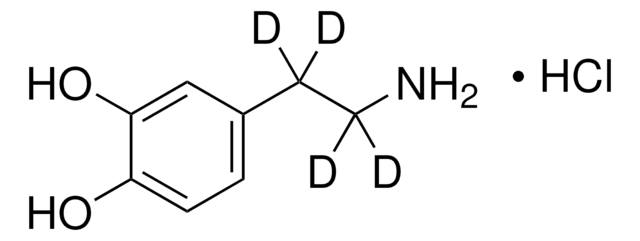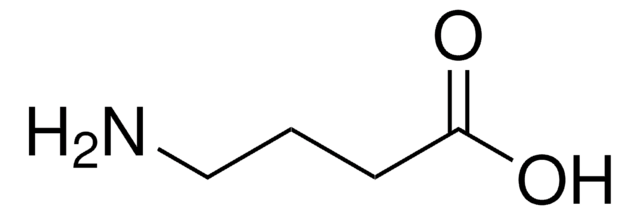95199
Fluoreszierender Dopamin-Neurotransmitter-Ligand, markiert mit Dansyl
suitable for fluorescence, ≥98% (HPLC)
Synonym(e):
Dansyl-C5-Dopamin
Anmeldenzur Ansicht organisationsspezifischer und vertraglich vereinbarter Preise
Alle Fotos(1)
About This Item
UNSPSC-Code:
12352116
NACRES:
NA.32
Empfohlene Produkte
Qualitätsniveau
Assay
≥98% (HPLC)
Form
solid
Fluoreszenz
λex 333 nm; λem 515 nm±5 nm in DMSO
Eignung
suitable for fluorescence
Lagertemp.
2-8°C
Allgemeine Beschreibung
This fluorescent labeled catecholamine neurotransmitter analog of dopamine (Product Name: DnsylD-1), with dansyl attached by a 5-carbon spacer arm to dopamine, provides a unique pharmacological tool. DnsylD-1 is a stable, receptor selective and high affinity pharmacological ligand that can be detected by fluorescent microscopy and FLIPR devices. Unlike recently reported synthesized fluorescent neurotransmitter analogs, DnsylD-1 contains the entire native dopamine structural moiety attached with the 5-carbon polylinker to the small fluorescence label dansyl. This structural modification minimizes steric hindrance, making DnsylD-1 an effective reagent for dopamine ligand binding and transporter uptake assays at namomolar concentrations.
A large stokes shift between excitation and emission maxima (Ex:Em, 313:515 nm) of DnsylD-1 provides high signal to noise detection with minimal autofluorescence. The dansyl moiety also changes spectral characteristics on intermolecular contact, facilitating biophysical characterization of ligand-receptor interaction. DnsylD-1 is a suitable substitute for radioactive ligand.
A large stokes shift between excitation and emission maxima (Ex:Em, 313:515 nm) of DnsylD-1 provides high signal to noise detection with minimal autofluorescence. The dansyl moiety also changes spectral characteristics on intermolecular contact, facilitating biophysical characterization of ligand-receptor interaction. DnsylD-1 is a suitable substitute for radioactive ligand.
Anwendung
Applications for Fluorescent Dopamine Ligand-Neurotransmitter (DnsylD-1)
DnsylD-1 has the following applicability due to the small molecular size of the dansyl fluorescent label, a long spacer arm between the dopamine structure and the fluorescent tag, stability in aqueous solution and low autofluorescence of the surrounding cellular or tissue medium.
DnsylD-1 has the following applicability due to the small molecular size of the dansyl fluorescent label, a long spacer arm between the dopamine structure and the fluorescent tag, stability in aqueous solution and low autofluorescence of the surrounding cellular or tissue medium.
- Histochemical imaging and quantitation of dopamine receptor expression in vivo and vitro.
- Pharmacological applications as a substitute for radioactive ligand.
- Dopamine metabolism and turnover analysis.
- Dopamine uptake analysis.
- Dopaminergic neuron detection.
- Analysis of disease conditions associated with altered dopamine synthesis, dopamine receptor expression or dopamine uptake: human disease research applicability in the following: a) Parkinson′s disease. b) Psychological disorder, including ADHD, schizophrenia and substance abuse. c) Physiological regulation of cardiovascular, renal and immune function.
Leistungsmerkmale und Vorteile
Highlights
- Dansyl labeled dopamine that operates selectively in binding and uptake assays at nanomolar concentrations.
- The native dopamine chemical structure is the major component of this fluorescent labeled catecholamine, which generates a fluorescent neurotransmitter molecule with high affinity toward all dopamine receptor subtypes, as well as to the dopamine transporter.
- The small dansyl tag with a 5-carbon polylinker to dopamine generates a stable, bright fluorescent signal with negligible steric hindrance.
- The dansyl fluorescent tag creates a large stokes shift minimizing autofluorescence and non-specific background signal.
- The fluorescent signal of DnsylD-1 is blockable by standard inhibitors to dopamine receptors and DAT.
- Standard inhibitors can also be employed to distinguish the interaction of DnsylD-1 with dopamine receptors and DAT.
- Fluorescence from DnsylD-1olocalizes with tyrosine hydroxylase thereby identifying dopaminergic neurons.
- To assay for dopamine receptor binding, first suspend the provided solid in DMSO (10 - 50 μl). Centrifuge and then dilute an aliquot of the supernatant into your assay buffer (for example PBS-BSA) to the desired assay concentration. DnsylD-1 when suspended in DMSO and frozen at -20oC is stable for at least 2 years. Detect DnsylD-1 by fluorescent microscopy, with a fluorescent plate reader or by flow cytometry. Set the fluorescent detection device to the following parameters: Ex/Em: 333/515 nm.
Sonstige Hinweise
Proprietary product of Fivephoton Biochemicals
Lagerklassenschlüssel
11 - Combustible Solids
WGK
WGK 3
Flammpunkt (°F)
Not applicable
Flammpunkt (°C)
Not applicable
Analysenzertifikate (COA)
Suchen Sie nach Analysenzertifikate (COA), indem Sie die Lot-/Chargennummer des Produkts eingeben. Lot- und Chargennummern sind auf dem Produktetikett hinter den Wörtern ‘Lot’ oder ‘Batch’ (Lot oder Charge) zu finden.
Besitzen Sie dieses Produkt bereits?
In der Dokumentenbibliothek finden Sie die Dokumentation zu den Produkten, die Sie kürzlich erworben haben.
Unser Team von Wissenschaftlern verfügt über Erfahrung in allen Forschungsbereichen einschließlich Life Science, Materialwissenschaften, chemischer Synthese, Chromatographie, Analytik und vielen mehr..
Setzen Sie sich mit dem technischen Dienst in Verbindung.